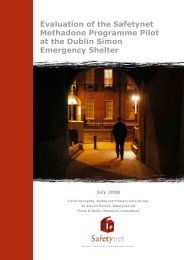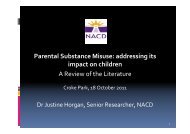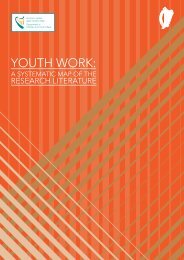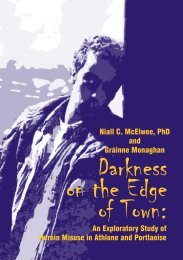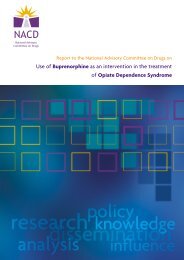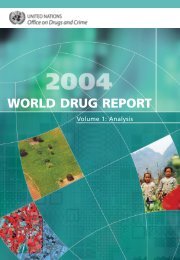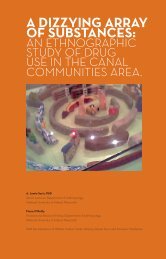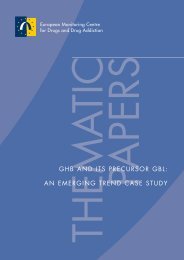Crack cocaine in the Dublin region - Health Research Board
Crack cocaine in the Dublin region - Health Research Board
Crack cocaine in the Dublin region - Health Research Board
Create successful ePaper yourself
Turn your PDF publications into a flip-book with our unique Google optimized e-Paper software.
10 Polic<strong>in</strong>g crack markets10.0 OverviewThis section reviews law-enforcement activities <strong>in</strong> relation to drug supply. The overallobjective of such activities is considered. Us<strong>in</strong>g data from a focus group with membersof <strong>the</strong> Garda National Drugs Unit, a description of street-based <strong>in</strong>terventions by AnGarda Síochána is provided. This <strong>in</strong>cludes Operation Plaza which was established<strong>in</strong> response to <strong>the</strong> emergence of crack <strong>coca<strong>in</strong>e</strong> <strong>in</strong> Dubl<strong>in</strong>. The role of <strong>the</strong> gardaí<strong>in</strong> divert<strong>in</strong>g drug users <strong>in</strong>to treatment and some of <strong>the</strong> challenges faced by lawenforcement <strong>in</strong> this area are also considered.10.1 Introduction: respond<strong>in</strong>g to drug supplyIt is important to consider what polic<strong>in</strong>g <strong>in</strong>terventions <strong>in</strong> illicit drug markets are seek<strong>in</strong>gto achieve and how specific market structures and forms of organisation can impacton <strong>in</strong>terventions. Polic<strong>in</strong>g <strong>in</strong>itiatives, be <strong>the</strong>y <strong>in</strong> terms of street patrols or <strong>in</strong>telligenceledoperations of a more covert nature, strive to disrupt markets and thus reduce orcontrol supply. On <strong>the</strong> o<strong>the</strong>r hand, demand-reduction strategies attempt to target usersand divert <strong>the</strong>m <strong>in</strong>to drug treatment, by means of arrest referral schemes, for example.It is assumed that by reduc<strong>in</strong>g supply and demand <strong>the</strong> market will ultimately shr<strong>in</strong>k anddrug-related crime will decrease accord<strong>in</strong>gly.A number of writers <strong>in</strong> this area have shown, however, that law-enforcement <strong>in</strong>itiativescan have un<strong>in</strong>tended consequences (Wilson and Stevens 2008). This is partly due to alimited evidence base <strong>in</strong> relation to supply-control activities. As May and Hough (2001:141) po<strong>in</strong>t out: ‘The relationships between <strong>the</strong> supply of illicit drugs, <strong>the</strong> demand for<strong>the</strong>m and enforcement activities are poorly conceptualised, under-researched and littleunderstood.’Apply<strong>in</strong>g basic market logic, it might be assumed that successful attempts to stiflesupply would lead to higher prices, and that this <strong>in</strong> turn would reduce consumption. Inreality, however, most estimates of prices throughout Europe show <strong>the</strong>m to be ei<strong>the</strong>rstable or fall<strong>in</strong>g (EMCDDA 2006). There are a number of possible reasons for this. First,it is estimated that law-enforcement activity leads to <strong>the</strong> seizure of only 10%–20% of<strong>the</strong> drugs <strong>in</strong> circulation; <strong>the</strong> amount that rema<strong>in</strong>s undetected is such that <strong>the</strong> longtermimpact of successful enforcement is likely to be m<strong>in</strong>imal (Connolly 2006a; UNODC2005). Second, drug distribution systems adapt quickly, so that where drug suppliershave been arrested, <strong>the</strong>y will quickly be replaced (Reuter et al. 1990). Third, demand isoften <strong>in</strong>elastic for problematic drug users, relative to moderate or recreational users,and <strong>in</strong>creased prices may simply lead <strong>the</strong>m to engage <strong>in</strong> greater levels of crime <strong>in</strong> orderto pay <strong>the</strong> higher prices (Wagstaff and Maynard 1988).100 <strong>Crack</strong> <strong>coca<strong>in</strong>e</strong> <strong>in</strong> <strong>the</strong> Dubl<strong>in</strong> <strong>region</strong>: an evidence base for a crack <strong>coca<strong>in</strong>e</strong> strategy




